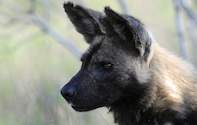Lower Sabie Game Viewing Routes
Kruger National Park
The Lower Sabie Restcamp overlooks the Lower Sabie Dam, which attracts a wealth of plants and animals, including Elephant and Waterbuck.Lower Sabie Rest Camp is a magnificent vision on the banks of the Sabie River. It is the perfect base from which to see game and birds in southern Kruger National Park. The camp overlooks Lower Sabie Dam, which attracts a variety of animals and birds, including Elephant. Waterbuck are very common in this area as well.
Several other striking waterholes are near the camp. A waterhole which is rather good for photography is Sunset Dam (off the H4-1), because you can get close to the water's edge. For
good game spotting and Lion prides, a visit to Duke's waterhole (S137) is also recommended. There have been a number of sightings of Cheetah and Wild Dog as well.
At Nhlambanyathi (S28)
there is a bird hide and a chance to get out of your car, while 4 kms (2.5 miles) to the south there is the large Nhlanganzwane Dam.
Due to these waterholes being
in close proximity to Lower Sabie, it's recommended to visit the waterholes very early in the morning or towards the end of the day when staying at the camp. The wildlife are usually most active at these times.
Wildlife Rhythms
Predators that are usually in Lower Sabie are
Lion, Leopard and Cheetah. Browsers and grazers include: white and black Rhino, Hippo, Tsessebe and Bushbuck to mention a few.
Lower Sabie to Skukuza (H4-1)
Lower Sabie Road (H4-1) follows the Sabie River
taking you to Skukuza. This is a very scenic drive with beautiful riverine forest fusing into Sabie Crocodile thorn thickets.
This road includes 2 eco-zones, which allows for an interesting mixture of grazers and browsers, and
baboon and vervet monkeys can be found in and under the Tamboti and Fig trees along the river banks. Apparently you can find more Leopard per square kilometre in this area than anywhere else in the world, so the chances of seeing these elusive creatures are better than average.
The
areas bordering the Sabie River have been through a big change since the rain floods in 2000. Perception of the environment has opened up because so many trees were uprooted and washed away when the river burst its banks, the reedbeds disappeared and the river now follows a slightly different course.
Some scientists argue that the
floods created some quick changes to an eco-system since the Park's beginning. The road between Lower Sabie and Skukuza is one of Kruger Park's most used routes, and the amount of tourist traffic has earned it the pet name of "Piccadily Circus".
Although the
distance between the 2 camps is only 43 kms (26.7 miles), one should allow 2-and-a-half hours for the drive, because you will be so excited with all the game viewing opportunities along the way. There is a picnic spot at Nkuhlu (the Swazi name for Natal Mahogany), about halfway to Skukuza, where snacks and refreshments can be purchased.
Lower Sabie to Tshokwane (H10)
One of Kruger Park's most
delightful drives for scenery and wildlife viewing is the road heading north from Lower Sabie to Tshokwane (H10). The road passes over the Sabie River and winds gently through Knob Thorn and Marula savannah, and the open grassland allows you to see game several kilometres away.
This sweetveld attracts some of the largest herds of Antelope, Zebra, Buffalo and Wildebeest in Kruger Park and there are often large groupings of grazers gathered together.
The large numbers of prey means that your chances of seeing Lion are particularly good along this route. The highest concentration of Giraffe in Kruger can be found in eastern grasslands between the Sabie and Olifants Rivers.
The H10 has some of the best scenery in the Kruger National Park. Mlondozi Dam picnic site combines stunning vistas over both plains and the Lebombo Mountains, with a
mixture of bird and animal life at the water's edge and in the surrounding area.
This is a
good place to see Marabou Stork, yellowbilled stork, Hippo and Elephant. Muntche Hill (435m) is also one of the easiest places in Kruger Park to note the differences between the flat basalt plains and the rocky rhyolite hills.
There is a 12km (7.4 miles) circular road (S122) around Muntshe Hill, which is rather pretty during the rainy season because the wildflowers go into bloom. There are usually
Kudu, Zebra, Wildebeest and occasionally Cheetah on this road.
One of the best viewing points in the whole of Kruger Park is Nkumbe, where the road
ascends into the Lebombo Mountain Range before descending toward Tshokwane. From where you stand you can look out over the Mlondozi River overlooking what seems to be like a limitless expanse of savannah.
Orpen Dam also has a good lookout point. A thatched shelter is perfectly place on the edge of the Lebombo,
giving a good viewing position onto the sandbanks below. The dam is on the Munywini River as it traverses from the grasslands through the Lebombo. The river is inhabited by Crocodile, Hippo, and the interesting landscapes provide wonderful views and excellent bird viewing.

Map of Lower Sabie Route in Kruger National Park...
more
From Lower Sabie Camp you have the opportunity to watch the endless procession of animals coming to drink at the Sabie River. Visitors canno...
more

 Map of Lower Sabie Route in Kruger National Park...
Map of Lower Sabie Route in Kruger National Park... From Lower Sabie Camp you have the opportunity to watch the endless procession of animals coming to drink at the Sabie River. Visitors canno...
From Lower Sabie Camp you have the opportunity to watch the endless procession of animals coming to drink at the Sabie River. Visitors canno...